How Photographer Bill Frakes Used 41 DSLRs to Shoot the Kentucky Derby
![]()
Native Nebraskan Bill Frakes has had a long career in which he has photographed in 138 countries and all US states. He has captured everything from Pulitzer Prize-winning images of Hurricane Andrew for the Miami Herald, where he was a staffer, to commercial work for Apple, Nike, Coca-Cola, Mars and Reebok.
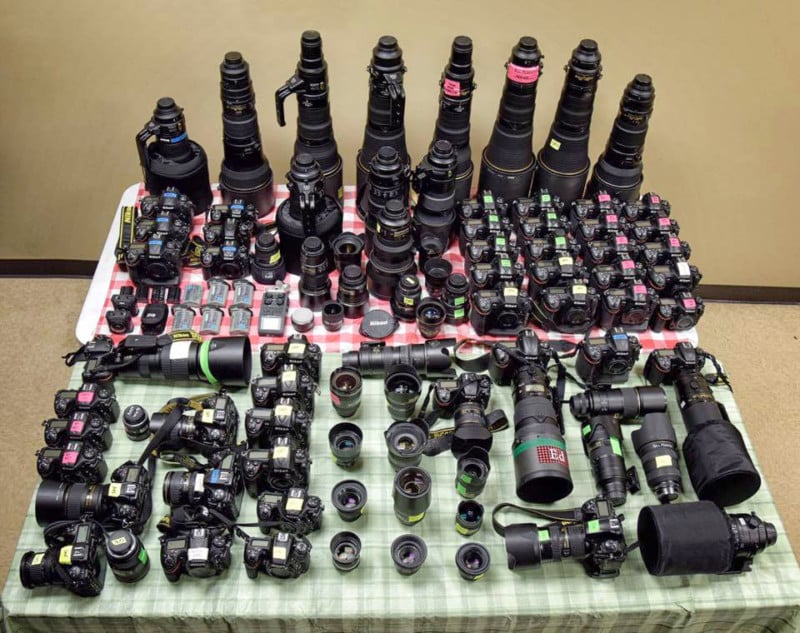
Packing for the Kentucky Derby.#nikonambassador #gitzo #manfrotto #nikon #twinspires #kentuckyderby #roadtrip pic.twitter.com/D3cV6dR1UC
— Bill Frakes (@BillFrakes) April 12, 2017
“If you can fall in love everyday,” says Frakes, a Nikon ambassador. “That’s the first step to being a great photographer.” He is currently on the masthead of Sports Illustrated, and is a frequent contributor to ESPN. At the University of Nebraska he is presently a professor of Journalism and has lectured at more than 100 universities.
We were impressed to see his feature story on the Kentucky Derby, which he exclusively shot for ESPN. At the same time, he was shooting for ESPN Waking Tall, a full-length photo feature on jockey Brian Hernandez, Jr. as he prepared for the grueling race.
We spoke to Bill Frakes to find out how he managed to capture so beautifully and perfectly the rain soaked, muddy and sloppy-tracked 143th running of the Kentucky Derby to record the most exciting 2 minutes in sports.
Phil Mistry: How long have you been shooting the Kentucky Derby?
Bill Frakes: I believe this was my 35th Kentucky Derby.
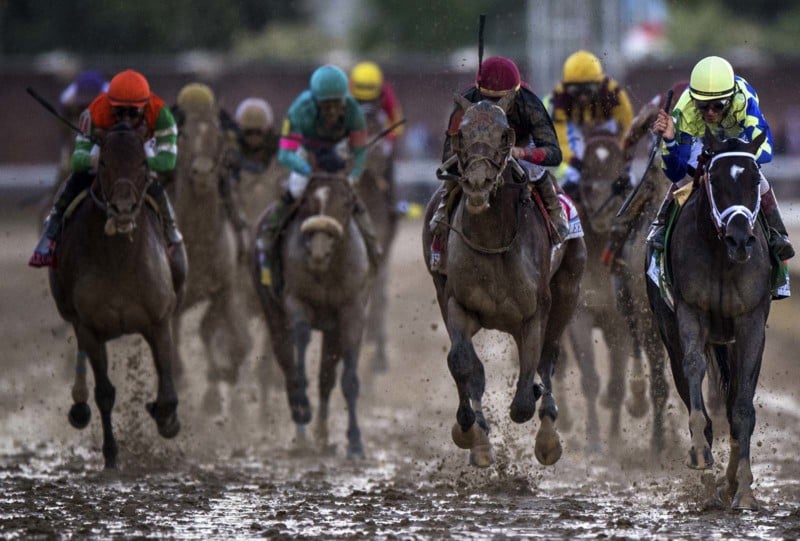
Give us a little insight into the process.
For this particular assignment I started talking with my editors three weeks in advance as to specifically how they wanted the final project to look.
The track is mile long oval. The race itself covers 1 and 1/4 miles. There are places where humans can be, and places where it is too dangerous—in those places such as under the rail, high on the roof, on light poles, on judges’ stands—only remotes are allowed.
The multimedia [timelapse] consists of a number of sequences made from different vantage points. The cameras aren’t moving. But the sequences cover some big distances so there is some calculation that has to be done.
The vast bulk of the images are done with fixed focus remotes. I personally place every camera. During the 12 hours before the race I go to each camera position multiple times working on the composition and the focus.
I determine at exactly what point the cameras have to be triggered—there’s a reason the same photographers consistently have the best results with remotes—it’s a thought process. On Derby Day alone I walked—according to my iPhone—close to 28 miles, and climbed 38 flights of stairs. It was raining, and the mud was deep. It wasn’t an easy day.
Of course I work with editors and assistants. At ESPN this is always a team effort: from concept to execution to production.
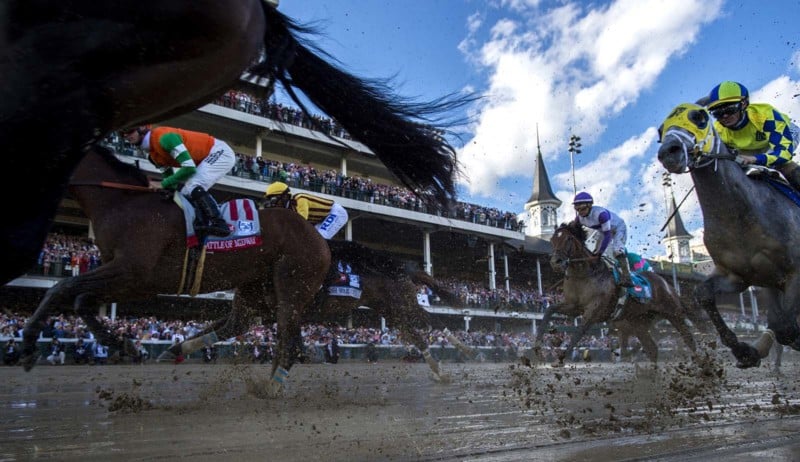
Which camera bodies were you using at this year’s Derby?
The Nikon D5, D500, D810, and D4s
Of the 41 cameras how many were shooting video?
Zero. I didn’t shoot any video. This [the embedded multimedia at the top of ESPN feature] is a collection of still images edited together in rapid time-lapse form.
Are you personally operating (looking through the viewfinder) of one camera or more than one? Or are you just working with everything on remote?
A Nikon D5 attached to Nikkor 600mm f/4. I also had a Nikon D500 with a Nikkor 20mm f/2.8 that I picked up when the horses passed close.
How many assistants did you have on race day?
I had assistants assigned to monitor every cluster of cameras. Churchill Downs is an incredible safe, hospitable place but for safety reasons I wanted someone watching each of the cameras.
10 assistants were stationed around the track helping take care of the cameras. Some were watching just one, some had an eye on as many as 7.
After the race was over how soon did you have to deliver the first results to ESPN?
ESPN had two editors on site. The second the race was over, the cards started flowing from the track to their editing station.
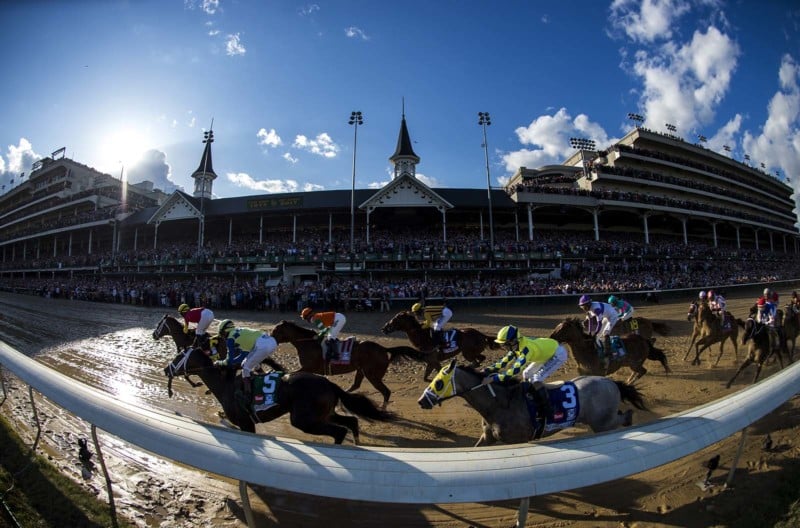
How soon was it before they had any of your photos on their site?
I would have to ask. My job was to ship the race cards and keep working.
The race multimedia [time lapse video] was only one of several projects we had going on Derby Day.
What is the biggest difference in shooting the Derby with digital instead of film? Do you feel the film days had some advantages?
Film was much tougher. The exposure latitude was not nearly as great. With many of the cameras it is impossible to access them for a significant time before the race starts. With fast moving clouds, on and off rain showers, and streaky sunlight it is an exposure nightmare on film.
When I was shooting film I would put pieces of gaffer tape on my leg so I could take notes about what the light was doing during the race. Then I could push or pull the transparency film accordingly from the different remotes. My cameras are exceedingly consistent, which has always helped my cause tremendously.
I love making images. Film was great, digital is wonderful. I’ve worked hard to learn how to get the most out of each.
Is it true that once in the film days you used 75 remote cameras to record the Kentucky Derby?
Something like that. I think it was slightly less, but a lot. That was also for a special project that had multiple uses.
Once the race is over are you over anxious, like most other photographers, to get to a computer to see your results?
I’ve been doing this a long time. I’m pretty confident about the results. The editors from ESPN are incredible. The fun part for me is seeing what they have chosen and how they are using it. It’s always better when they are finished. I love the collaboration and interaction.
What is one thing you worry about the most that can go wrong when doing this kind of remote shoot?
I do a tremendous amount of prep work. I try not to leave anything to chance. Which means I worry about everything, right up to race time. Then I relax.
What advice would you give a professional photographer who is photographing his first Derby?
Do your homework. It’s a big place, full of tradition and fantastic visual opportunities. A place where art, fashion, food, music, sport and culture intersect. If you’re not ready it can be overwhelmingly wonderful and you could get lost.
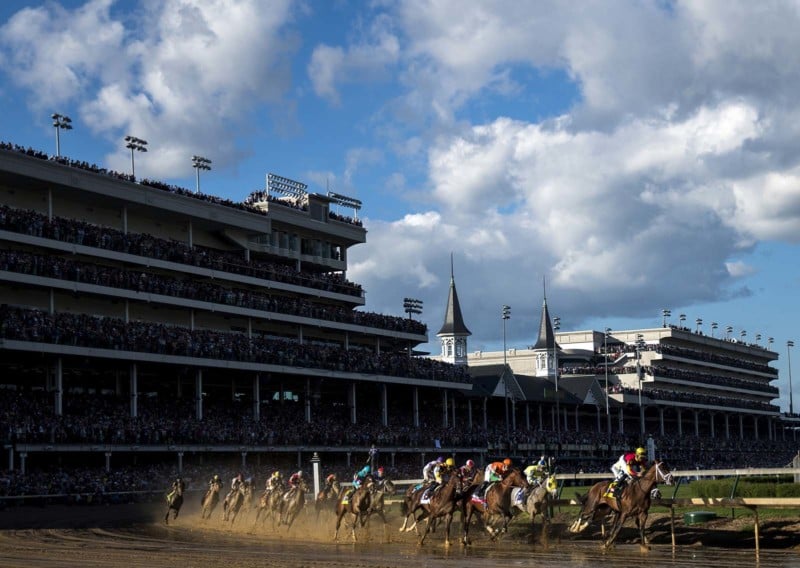
Roughly how many frames did you shoot in total?
This is something that seems to be of interest to many of the readers, but it’s something that simply didn’t matter to me. All of the cameras fired at the appropriate times for the durations I wanted.
I suppose you start placing your cameras out on the track only on race day. Can you tell us how early do you start and how your workday progresses on race day?
Churchill Downs requires that certain of the remotes be in position the night before. Because of the constant rain I got started putting those in position a bit later than usual this year. I left the track at about 10:30 pm Friday evening. I was also shooting a big feature package on one of the jockeys in addition to the multimedia race piece.
I returned to the track at between 5:30 am and 6:00 am. The rest of the day was spent alternately shooting features, installing cameras, checking and rechecking, working on the wiring, adjusting camera positions, talking with the editors, and making sure nothing was blocking any of my cameras. This was complicated by the rain.
After the race it is the process of cleaning the cameras, lenses and remotes and repacking the cases for shipping. I got back to my lodging at a little after midnight. I took a shower, cleaned up and then drove to Cincinnati to fly back to Florida on a 5:30 am Sunday morning flight.
You used the D500, cropped sensor, along with other full-frame sensors cameras. Which format do you prefer and why?
I use different cameras to accomplish different things. I don’t really have a preference.
Are you shooting RAW or JPG for quick delivery?
I shoot RAW and JPG combined.
Do you have a method of where you place the remote cameras? Like so many in the home stretch, etc?
I spend hours planning where I need to place each camera to derive the look and feel I want. There is no set formula; it’s a calculation each time.
Do you think that in the future there would be a camera that runs on the rail for the entire course for a second-by-second coverage?
I am confident they could build the technology to run a camera all the way around. Whether it would be allowed is another matter altogether.
You can follow Bill Frakes and see more of his work on his website, Twitter, Facebook, Instagram, StrawHatVisuals and NebraskaProject.
Correction: We originally stated that 35 cameras were used. Frakes has confirmed that he used 41 cameras shooting 35 different angles.
About the author: Phil Mistry is a photographer and teacher based in Atlanta, GA. He started one of the first digital camera classes in New York City at International Center of Photography in the 90s. He was the director and teacher for Sony/Popular Photography magazine’s Digital Days Workshops. You can reach him via email here.
Image credits: Header photograph by Bill Frakes for ESPN